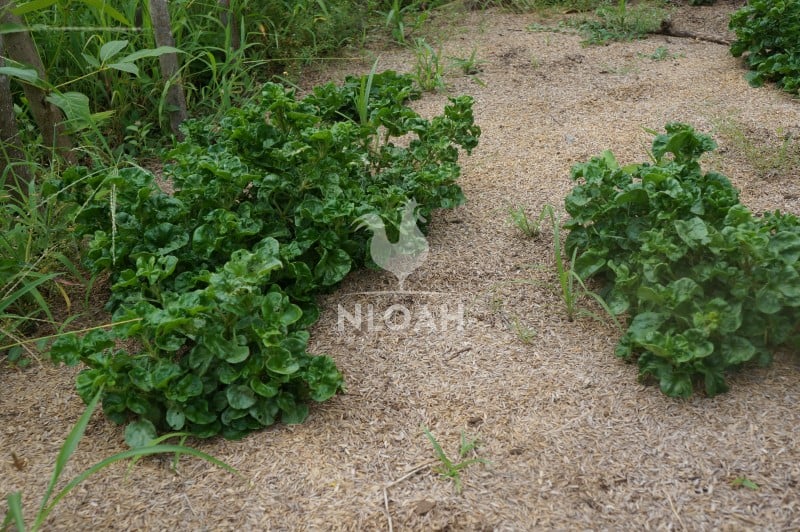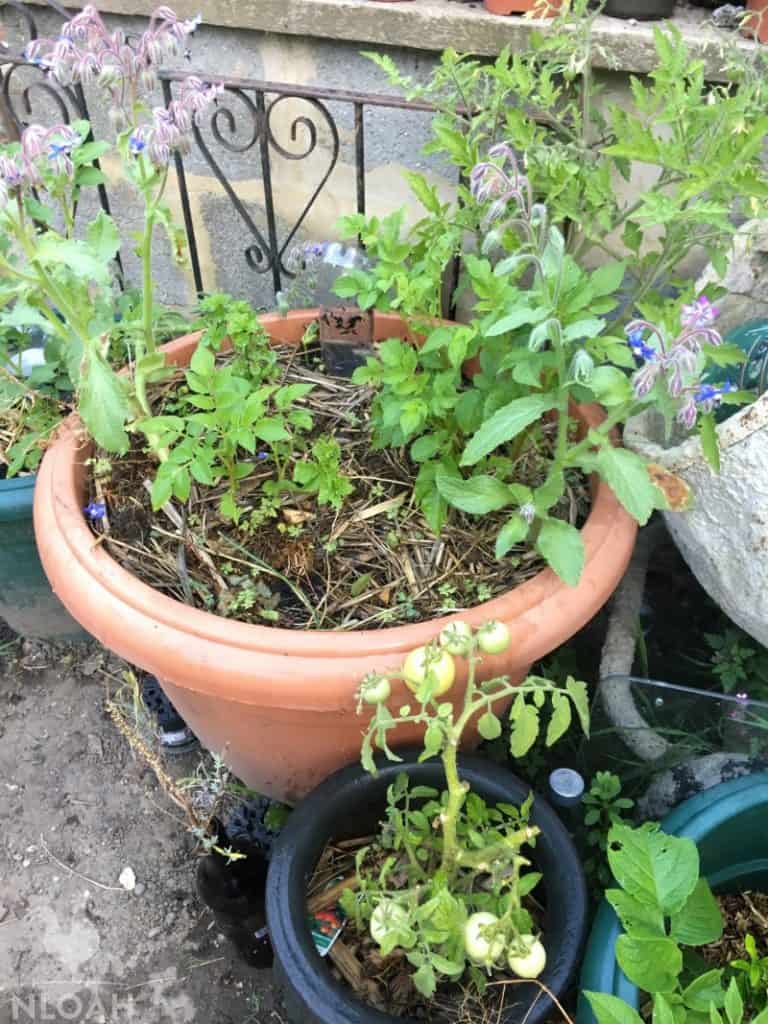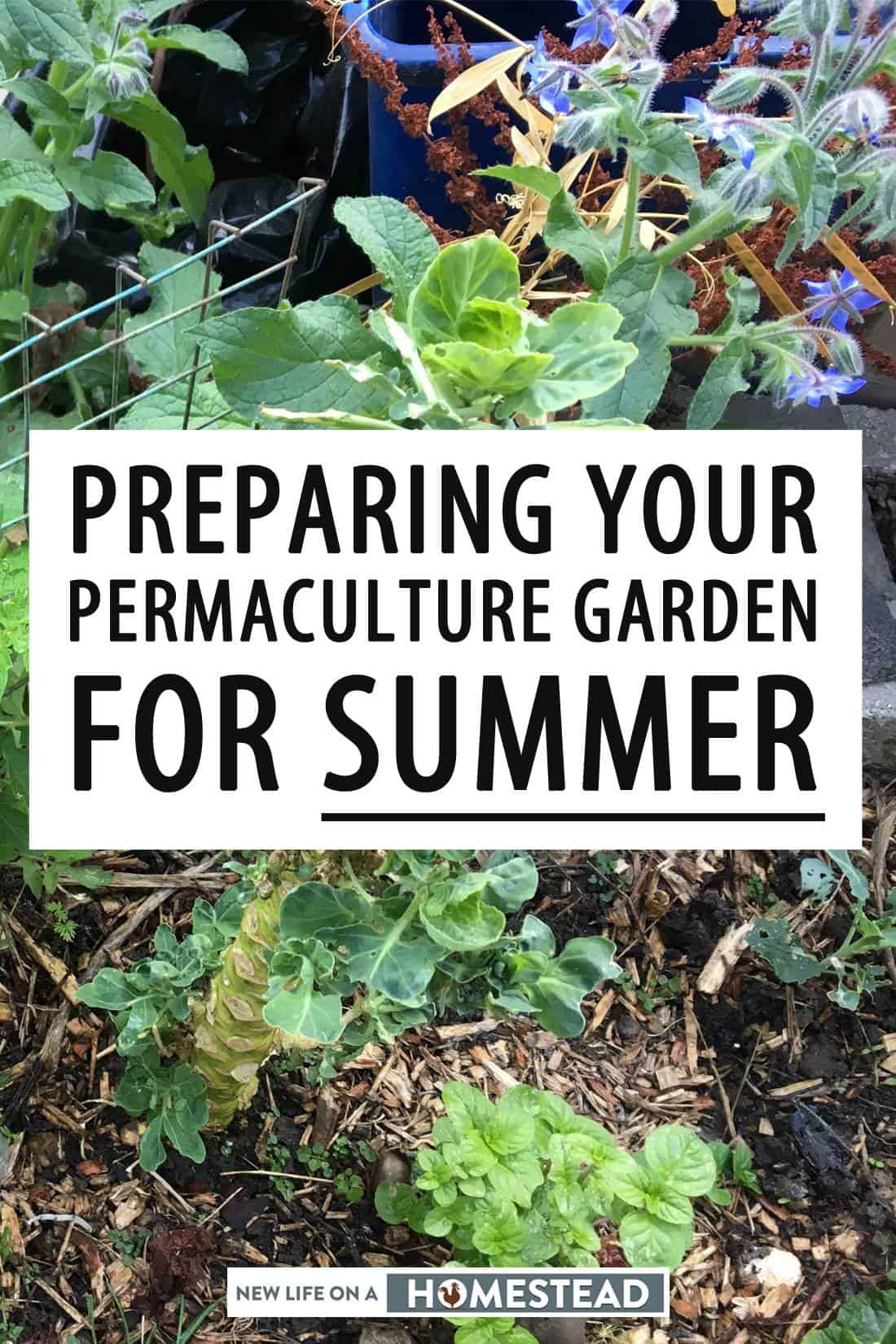First if you haven’t yet got around to starting your permaculture garden, Summer is the very best time to start planning what you will do come the fall. But for the rest of this article, we are assuming you have already got things in place and been developing your garden during the previous seasons.
Early summer is such an exciting time to be in the garden. Plants are growing stronger and faster due to the warmer temperatures and increased sunlight.

Hopefully you carried out the preparatory work and planting in the early spring, and now your garden will be starting to reward all that hard work. You may already be harvesting some of the early crops.
Certainly there will be abundant growth – no doubt! Summer is a wonderful time in any garden but of course comes with its own challenges of how you will keep your plants fed and watered.
The Toolshed
Over the winter and spring you tidied the toolshed, repaired any broken tools, and replaced any that were beyond repair – you did do that, didn’t you?
So now your equipment is in good order, and will have been well serviced by now. It’s really important that you maintain your tools. This is the time that you are using them regularly and you want to try to extend their natural life if possible.
Looking after them, checking, cleaning, and oiling them after each use is essential and will save you money in the long term. Brush away any dried on mud with a stiff brush.
Making sure tool handles are well fixed is also an important safety measure so check screws and fixings regularly.
Another equally important reason to make sure your tools are clean and in good order is that dirty tools, tools covered in mud together with decaying vegetation can harbor pests, and spread disease.
Of course you will be needing your lawnmower frequently at the moment. Keep it well serviced and if you haven’t done so, give it an oil change.
For the first few weeks, you should cut the lawn on a high setting. Feeding your lawn and cutting it often will encourage new healthy grass to grow in your lawn.
If weather conditions permit (if it’s not too hot or too dry), you can sow grass seed in any bald or thinning areas of your lawn. If the weather conditions aren’t favorable, it’s better to wait until September.
Keeping an Eye on Things
Observation is the most effective way to make sure your garden is healthy and productive. Make a journal, marking days you plant and harvest your crops. If you also make a note of weather patterns you will see how the natural environment is impacting your garden.
By close observation, you will also come to realise what plants are not doing so well and which ones thrive in your soil conditions.
Work with the conditions you have as far as possible, rather than trying to work against nature. It’s so much easier! Why try to grow azaleas or heather in chalk where you will have to work so hard adding acidity to your soil.
There are many alternatives available, such as ox-eye daisies, cornflowers, lady’s slipper, and marjoram. These lovely plants will come back year after year. They will also attract a multitude of insects such as butterflies and bees and require little or no watering.
Some fruit trees also prefer a chalky soil such as the Asian pear. Plants such as sedums and alpine plants are also drought resistant.
If you made a journal such as this in previous years, comparing the current year’s results with those of previous years will give you important data to work from.
Make sure you regularly carry out a thorough walk of your garden, taking a note of the changes that have occurred since you last did this.
Don’t be tempted to stop as you see little jobs that need doing! This will distract you from the purpose of observing. Instead if you think you may forget something, use your notebook and make a “to do” list!
This can include noting down your observations on the location and types of pests you do not want in your garden.
This observation exercise is also a great opportunity to check for any signs of disease. By regularly walking and looking carefully at your plants, you will be in a far better position to nip such potential troubles in the bud.
Early Summer Planting
By early summer, your early crops will be ready to harvest. Good examples are rocket, radish, salad, spinach, cress, and delicious early potatoes.
Some of your vegetables such as carrots, would have been planted early on as they needed some colder weather to germinate. Leafy greens such as kale, rocket, chard, and spinach also do better if they’re planted early. They have a tendency to go to seed quickly if planted when it is warm.
The vegetables you should continue to sow in open ground are French beans, peas and salad crops early in the summer.
The first sowing of the peas which were started in the cold frame can now be sown direct in the soil. The peas will fix nitrogen in the soil. Because peas climb, you take advantage of additional planting space.
Tomatoes can now be planted out safely. It is also the time to plant brussel sprouts, winter cabbage, and leeks.
During the summer months, there will be the pleasure of harvesting your abundance of fresh veggies.
As well as vegetables, you want your garden to continue looking bright and colorful so this is the time to plant summer flowering plants and bulbs and you will reap the benefits of having your garden a riot of color as well as full of tasty, fresh veggies.

Take Care in the Sun
Remember that during the summer, the heat and strength of the sun can be damaging to plants – and you.
In some areas, the temperatures can rise so much that plants can burn in the sun. Even temporary heat-waves can cause plants to suffer.
If this is the case where you are, you may need to create some sort of shading for your plants. Then you can protect them on extremely hot days. The shading can be temporary, so it doesn’t need to look tidy. You can even use old discarded beach umbrellas!
The best time to garden during the summer months is early morning or in the evening when the days are long and the heat has subsided into a pleasant warmth. This will avoid you getting sunburn or heatstroke. This is even more important if you are working with young children.
Around the edges of your garden, you might want to consider planting deciduous trees. These will provide you with shade from the heat of the sun at the height of the summer.
Once the leaves have fallen, the important winter sun will still be able to penetrate, and give light and warmth. Just make sure that the trees aren’t going to be competing with the plants for water and nutrients.
Maximize Water Conservation
Many of your vegetables will hold huge quantities of water and require considerable water if they are to grow and remain healthy.
Having sufficient water available for all your plants in summer can be a challenge. If you have a method to collect and use rainwater, this is the ideal solution. Rain is not treated with chlorine, and is far better for plants as well as the environment.
Rainfall is typically collected on the permie garden using swales. If you don’t have any set up, you may want to observe water runoff in your garden, and dig them accordingly.
You can, of course, buy water butts, but they can be expensive. But you can acquire them too often for free at a local recycling center. Some councils also encourage the use of water butts for private gardens, and offer them for sale at cost effective prices.
Some water butts have the facility for attaching pipe-work to downpipes, adding taps and even for diverting the water away to a drain once the butt is full.
If, despite your attempts to collect water, you still find yourself short of water at the height of summer, consider a large rainwater collector attached to a shed.
There are also other ways in which you can save water apart from collecting rainwater. Mulches can reduce or even eliminate evaporation of water in the soil. The other great benefit of a mulch is in its role as a weed suppressant.
It is a good idea to use a mulch in between rows of plants such as peas or beans. You will have less competition for the nutrients from weeds and therefore obtain higher yields from your crops. If you have recently planted trees or soft fruit bushes, then a mulch around the base of these is also recommended.
The choice of mulch material depends on budget, availability and of course this depends on your own circumstances.
Most expensive of course is the commercial weed suppressant which will completely exclude weeds (until you cut or tear it with a garden fork or spade!). This is a good choice for permanent cover under paths.
You can also use cardboard, newspaper, straw, compost, or sheep’s wool. You can use anything which is biodegradable.
Although you can even use an old carpet, many carpets are made of synthetic material. Synthetics will take a long time to rot, and they will deliver fragments of plastic into the soil, so unless made of natural fibres, they are not a good choice.
You should always apply the mulch when the soil is damp. It is difficult for rainwater to penetrate a barrier of mulch, so applying it when the soil is damp makes the mulch more effective at retaining water.
Once your mulch is in place, the most water efficient method for watering your plants is to use a drip irrigation system positioned below the mulch. This should be operated ideally on a timer. Having a timer will help to ensure you don’t overwater.
Set your watering for early morning or late evening so the water will not evaporate instantaneously. The water will be able to be absorbed by the soil outside the heat of the day.
Additionally, if you water when the sun is directly overhead, you risk scorching the foliage of your plants.
Finally, when watering, it is better to water less often, but more thoroughly. The water will sink deep into the soil, and encourage the plants’ roots to go down deep as well.
If there is a water shortage in your area, you can reuse grey water. Grey water from the kitchen washing up is fine, providing you use a biodegradable washing up liquid.
You may have external piping from an upstairs bathroom. If this is the case, you can fit a rainwater diverter and pipe waste water from your bath or shower into a water butt or directly to your vegetable garden.
If you do this, you should also add a home-made filter. This will prevent soap residue building up in the bottom of the water butt and causing an unpleasant smell.
Simply use a few balls made from old tights, or used pan scourers, and place them in a sieve or colander below the output.
Slug Problems!
Unfortunately, slugs love damp, decomposing mulch. Of course, you need to protect your small seedlings from being decimated by slugs and snails.
Certain seeds claim to be relatively slug resistant but the most effective way to remove them is to introduce ducks to your garden. They are the ideal remedy to the slug problem.
Slugs forage early morning and early evening. This is the time for your ducks to be allowed into your vegetable garden. Make a temporary enclosure for them, and make sure they don’t trample any newly germinating seeds with their large webbed feet.
Other possible solutions to the slug problem can be found or created. So if ducks aren’t an option for you, consider a meadow or wildlife area, a natural fish-free pond, and even your compost heaps can encourage populations of slug eating predators.
You can be quite creative as well as effective. Make slug barriers from circles of grit or better still copper.
You don’t need to resort to buying these, they are easy to make. Simply cut up any old copper you have lying about into circular shapes. For a slug, copper is the ultimate barrier, their equivalent to an electric fence.
Raised beds are good too, if you surround them with woodchips. Slugs and snails do not like to cross the paths.
Spread hair trimmings, egg shells or the dust from the bottom of a bag of charcoal around the bases of your new plants. This will also make an effective deterrent. You can make beer traps to prevent slugs and snails too, and these work well.
If you have a greenhouse, use it to germinate your seeds, and only plant outdoors once they are sufficiently robust to have some resistance to a slug chomping through their leaves.
The final, and most time consuming option is probably the most effective, and a good idea even when other methods are employed. In the evenings, go into your garden with a torch and pick off all the snails and slugs.
With all these options available to deter slugs and snails, there is no reason to resort to the simple slug pellet option. Indeed the risk to birds from eating a poisoned slug, and the risk to small children from eating the pellets should be sufficient to ensure you don’t use them.
Tidy up!
Once you have tidied up your beds and borders, and removed any remaining debris, you can tidy up the edges of the borders. Trimming the edges of your beds makes everything look neater.
You will have found that over the last few weeks of spring, your bushes and trees will have started to burst into life. But you need to pay particular attention to cutting back and removing any dead wood.
Cut back all dead, or decaying branches and leaves from fruit trees or fruit bushes. If you don’t do this, new buds may fail to form, depriving you of this year’s valuable crops. Pruning and dead heading climbers will enable them to flower during the spring and summer.
Maybe not Your Favourite Job – Weeding
This is also the time for weeding and whilst many people hate weeding, it is an essential part of any garden maintenance.
Of course it always looks tidier when it is done, but the most important reason to keep up with weeding is to stop weeds stealing goodness from your soil. You didn’t condition, mulch and feed your soil for the weeds’ benefit, did you?
Your mulch should be helping to keep most weeds under control, but you will probably find that invasive specimens are a nuisance. You need to pull them out – making sure to get all the roots out so they don’t grow back.
If you are pulling weeds that are seeding, you need to put these into your compost pile in the middle. The heat of the compost pile will burn and kill the seeds.
Those that aren’t seeding, and that don’t re-root easily, can be used for sheet mulching or put into large buckets of water which will ferment into fertilizing weed teas.
The Cold Frame
Your cold frames which allowed you to get your seedlings going early are probably now redundant since there is no longer the risk of a late cold spell.
Any plants which you do still have inside will be liable to suffocate if there is insufficient ventilation. They will also die of heat if the frame is kept closed and the temperature is more than around 65 degrees F / 18 C.
If your cold frame was of a temporary construction, then you can remove its structure, remove any pots or plants, and clean up the soil.
If you planted directly in the ground, then the cold frame structure can simply be removed, and the plants can remain there. Plants love this, as their roots don’t get disturbed at all.
You may even have built your cold frames from old bales of straw, in which case you can now use them as a mulch material. Be wary of using hay bales though, they may still contain seeds which will be liable to germinate in the warm weather.
Bird Tables
Once winter is past, it is easy to forget our feathered garden friends. They are no longer in need of your food scraps, for nature provides an abundance of its own.
But the bird tables, need to be cleaned too. They will appreciate your keeping water baths refilled, particularly when the weather is hot and available water is in short supply.
Patios and Decking
First job, collect any rubbish and clear the area. If weeds have grown between paving slabs, decking or cracks in the patio surface, now is the time to remove them. If the paved area has become discolored or dirty with moss, then give the area a high pressure wash with a pressure washer.
This will remove any dirt caused by vegetation or rain to be lifted and leave your patio as good as new.
Garden Furniture
Your garden furniture needs to be ready for the long, lazy days of summer too. This is when you will need it! So treat it now making sure you have carried out any repairs that are necessary. If your furniture has been over wintered in the garage, it will have collected dust and dirt.
If it’s wooden furniture then now is the time that it needs to be treated to preserve both the condition and the color of the wood. It’s a job well worth doing; your furniture will last longer, look better and also protect it from spillages.
Finally, Enjoy!
Now you’ll be ready to invite your friends to come and join you on a nice day for a barbecue or garden party. So you better get that barbecue out too, give it a good clean and make sure you have all the necessary tools and fuel to hand so you can get cooking outdoors just as soon summer arrives!


Sally is a retired English lawyer who spent 20 years homesteading on the Welsh hillsides in the U.K.
Semi-retired, she moved to France 15 years ago, where she and her husband set about restoring a 14th century watermill which came with 5 hectares of woodland, riverbank, and pastureland.
Using the skills and experience gained in the U.K, they continue to enjoy working on their land, woods and water.
